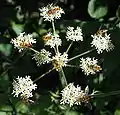Episyrphus balteatus
Episyrphus balteatus, sometimes called the marmalade hoverfly,[1] is a relatively small hoverfly (9–12 mm) of the Syrphidae family, widespread throughout the Palaearctic region, which covers Europe, North Asia, and North Africa. The upper side of the abdomen is patterned with orange and black bands. Two further identification characters are the presence of secondary black bands on the third and fourth dorsal plates and faint greyish longitudinal stripes on the thorax. Its color patterns may appear wasp-like to other animals, such as birds, protecting it from predation.[2]
| Episyrphus balteatus | |
|---|---|
_male.jpg.webp) | |
| male Whitecross Green Wood, Oxfordshire | |
 | |
| female | |
| Scientific classification | |
| Kingdom: | |
| Phylum: | |
| Class: | |
| Order: | |
| Family: | |
| Subfamily: | |
| Tribe: | |
| Genus: | |
| Species: | E. balteatus |
| Binomial name | |
| Episyrphus balteatus (De Geer, 1776) | |
| Synonyms | |
E. balteatus can be found throughout the year in various habitats, including urban gardens, visiting flowers for pollen and nectar. They often form dense migratory swarms, which may cause panic among people for their resemblance to wasps. It is among the very few species of flies capable of crushing pollen grains and feeding on them. The larva is terrestrial and feeds on aphids.
As in most other hoverflies, males can be easily identified by their holoptic eyes, i.e., left and right compound eyes touching at the top of their heads.[3][4][5][6]
Gallery
 Female marmalade fly feeding on a Hebe speciosa flower
Female marmalade fly feeding on a Hebe speciosa flower.jpg.webp) Close-up of the head sitting on a flower of a grey-haired rockrose (Cistus incanus): The fly head has a diameter of 0.1 in (2.5 mm).
Close-up of the head sitting on a flower of a grey-haired rockrose (Cistus incanus): The fly head has a diameter of 0.1 in (2.5 mm). Group on hogweed
Group on hogweed
References
- "Marmalade hoverfly - Episyrphus balteatus". Natural England. Archived from the original on November 20, 2008. Retrieved December 17, 2009.
- Bain, R. S., et al. (2007). The key mimetic features of hoverflies through avian eyes. Proceedings of the Royal Society of London B: Biological Sciences, 274(1621), 1949-54.
- Ball, S.G.; Morris, R.K.A. (2000). Provisional atlas of British hoverflies (Diptera, Syrphidae). Monks Wood, UK: Biological Record Centre. pp. 167 pages. ISBN 978-1-870393-54-6.
- Morris, Roger K. A. (1999). Hoverflies of Surrey. Surrey Wildlife Trust. p. 244. ISBN 978-0-9526065-3-6.
- Stubbs, Alan E.; Falk, Steven J. (1983). British Hoverflies: An Illustrated Identification Guide. British Entomological & Natural History Society. p. 253, xvpp.
- Van Veen, M.P. (2004). Hoverflies of Northwest Europe, Identification Keys to the Syrphidae (Hardback). Utrecht: KNNV Publishing. p. 254. ISBN 978-90-5011-199-7.
- Verrall, G.H. (1901). British flies, vol. 8: Platypezidae, Pipunculidae and Syrphidae of Great Britain, reprint, 1969, E. W. Classey, Hampton.
- Chiney, Michael (2007), Insects of Britain and Western Europe. Domino Guides, A&C Black, London
External links
- "Oldstyle id: 1f074b5bce1af7524c876c006a0ef925". Species 2000 & ITIS Catalogue of Life. Species 2000: Naturalis, Leiden, the Netherlands.
- External images